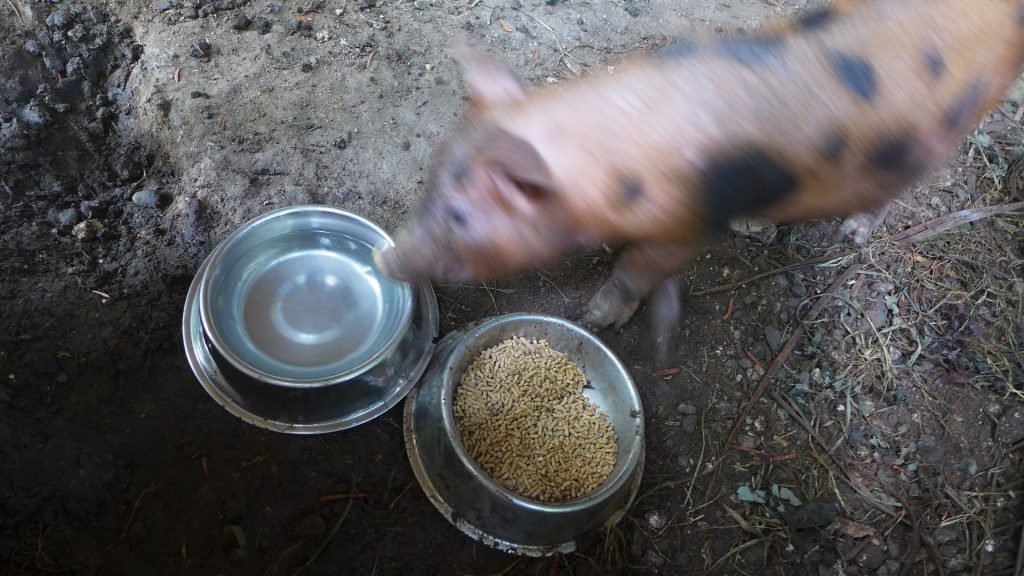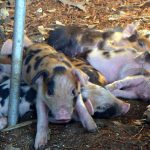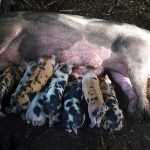When we started breeding and raising pigs in a backyard setting, we decided to keep everything small-scale and as close to nature as our resources could allow. Ideally, this means pasture-raised pigs. However, we don’t have the luxury of the space. So we kept only a few pigs and provided spacious accommodation for them, roughly about 20-25sqm for 1 boar or 1 sow or 5 growers.

We built pens for our pigs that are large, well ventilated and get plenty of sunshine. The pens have grass, bushes and soil flooring, not concrete. Apparently, pigs love rooting and digging the soil, thus, the conventional pigpen designs with concrete flooring would be against our principles.
The natural principle also means giving pigs plenty of green forage, fruits, roughage and other organic materials to eat. Again, our limited resources make it impossible to give even a few pigs 100% natural diet. So we supplement with commercially-produced pig feeds in pelleted form.

To imitate the pig’s preferred natural habitat of the forest, we introduced plenty of organic material (mostly dry coconut leaves) which absorbs moisture and urine and at the same time provides soft bedding for the pigs. When a pig gives birth (or farrows), we provide plenty of dry banana leaves for nesting. Every now and then, we put wood shavings and rice hull into the pens to keep the flooring dry and provide entertainment for the pigs. Ashes and burnt pieces of wood from cooking are also collected and placed into the pens after we learned that ashes were good for piglets.

Perhaps due to the “lucky” combination of these conditions, our pigpens did not emit irritating odors. The only time we had an odor problem was when the roof of the pen started rotting and rain flooded the area. It seems that a large majority of irritating odor problems associated with pigs take place when the water content of beddings are over 30% and in the case of concreted floorings, when water, urine and manure are mixed, no matter the amount or proportion. This is why concreted floor pens need to be cleaned and washed with large amounts of water several times a day. Our pigpens never need cleaning.

We have had 4 farrows with no incidence of disease amongst the piglets. This is surprising for many who see the piglets amidst soil, rotting vegetation, manure, urine and mud, all widely perceived as unhygienic conditions. While we have had no problems after 2 years, we do think about the possibility of build-up of pathogenic bacteria in the pigpens after a longer period of time. This is why we are currently taking measures to rotate the pigs in different pens so as to enable the vacated pens to fallow and completely turn into compost before seeds of cover crops are sown over the area.

After 2 years, we seem to have established a system of pig-keeping based on farming philosophies more widely known as Natural Farming (pioneered by the Japanese Fukuoka Masanobu) and Korean Natural Farming (KNF, promoted by the Korean Han Kyu Cho). These are broad farming philosophies and principles that have numerous applications.

Although our own principles and practices are fairly successful so far, we are now experimenting with KNF, particularly, the role of the diversity of indigenous microorganisms and beneficial microorganisms in keeping healthy pigs in a healthy natural environment. We are particularly curious how the more focused and directed approach of microorganism production and harvesting would be most useful – not only for livestock, but for crops as well.

As part of our pig raising experiments, we have a smaller pen, about 2sqm under the house, where a 10-week old piglet is kept. The piglet is fed a high-density diet (crude protein of about 16%) and a small amount of fruits and forage materials such as trichanthera (madre de agua), banana leaves, ipil-ipil, papaya, etc. Odor events in this pigpen are more frequent and were greatly minimized by spraying the area with lactic acid bacteria solution (known in KNF as LABS, made by fermenting rice washing with milk) and fermented plant juice solution (known in KNF as FPJ, made by fermenting shoots and leaves of vigorously growing leafy vegetables and brown sugar). These are also added to the piglet’s drinking water. Occasionally, wood shavings are thrown over the manure then sprayed with the solutions mentioned above. Given the small space for this piglet, the results of using fermented solutions have been impressive. We are yet to successfully produce indigenous microorganisms (known in KNF as IMO) and introduce that to our pigpens and surrounding gardens together with FPJ and LABS.

While NF and KNF systems seem to work quite well for us, we will be regularly sharing results of our experiments in the near future. We do have a number of failures which we will share here as well.
In the meantime, below are some resources that might help those interested in learning more about natural farming. Good luck!
Websites:
E-Books
Books
YouTube Video Channels






